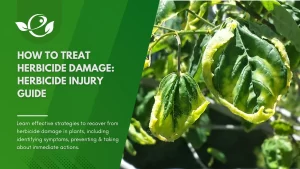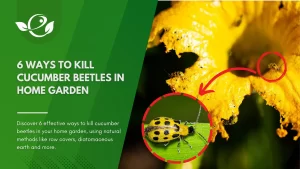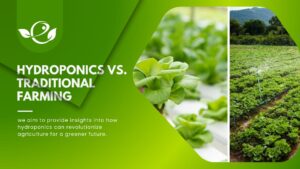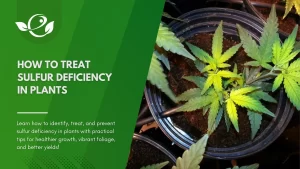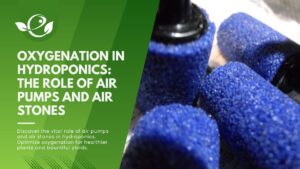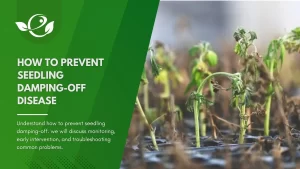Table of Contents
Welcome, curious minds and green thumbs alike, to the ultimate guide on perlite! 🌱 Whether you’re a seasoned gardener looking to take your greenery to the next level or a newbie just dipping your toes into the soil, you’ve come to the right place. In this comprehensive article, we’re going to dive deep into the wonderful world of perlite, exploring its benefits, sharing expert tips, and showing you exactly how to prepare and use it to transform your plants into the envy of the neighbourhood.
So, grab your gardening gloves and get ready to learn everything you need to know about this magical, lightweight, and airy mineral. We promise, that by the end of this guide, you’ll be a pro gardener, ready to take your gardening game to new heights (literally if you’re growing climbing plants). Let’s dig in!
What is Perlite?
It is a unique volcanic glass that is formed through the natural process of heat and pressure on volcanic obsidian. It is an amorphous mineral that expands when heated, becoming a lightweight and porous material. The expansion is due to the presence of 2-6% combined water in the crude perlite rock.
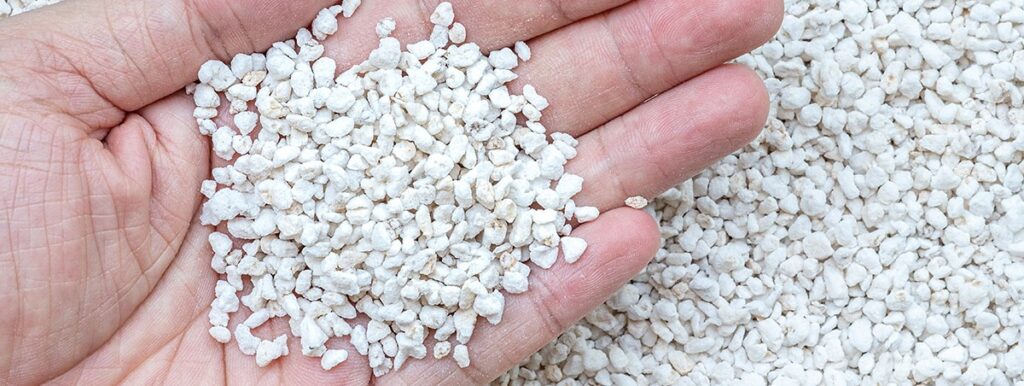
Composed primarily of silicon dioxide (SiO2), perlite has a unique internal structure that consists of numerous tiny glass bubbles. These bubbles are responsible for their lightweight and porous nature, making this an excellent choice for various horticultural applications. It is extracted from open-pit mines, crushed, and then heated in industrial furnaces at temperatures above 800°C (1472°F). This heating process turns the raw perlite into a lightweight, sterile, and highly absorbent material.
A. Composition of Perlite:
Chemically, it contains about 71 to 75% silicon dioxide, 12.5 to 15% aluminium oxide, and smaller amounts of other elements such as potassium, sodium, iron, and magnesium. The precise composition of perlite can vary depending on its source, but its unique porous structure remains consistent.
B. Processing-Perlite:
During the processing, the heat causes the combined water in the volcanic glass to vaporize, creating countless tiny bubbles. These bubbles dramatically expand the volume of the perlite, resulting in a lightweight material with a low bulk density.
The expanded perlite is then graded to different particle sizes based on its intended use. It can range from fine powder-like particles to larger granules, each offering specific benefits in various applications.
| Benefits of Perlite: | Horticultural Applications: |
|---|---|
| Lightweight and easy to handle excellent drainage properties Retains moisture and nutrients improve aeration and root development Neutral pH resistant to pests, diseases, and decay | Lightweight and easy to handle excellent drainage properties Retains moisture and nutrients improves aeration and root development Neutral pH resistant to pests, diseases, and decay |
Why Use Perlite in Hydroponics?
It offers numerous advantages for hydroponic systems, making it a popular choice among growers. Its lightweight nature, excellent drainage properties, and ability to retain water and nutrients make it an ideal Grow medium for hydroponic cultivation.
One of the key benefits of perlite in hydroponic systems is its lightweight composition. Compared to traditional soil-based growing media, it is significantly lighter, allowing for easier handling and manoeuvring within the hydroponic system. This lightweight characteristic also enables better aeration and root development, promoting healthy and vigorous plant growth.
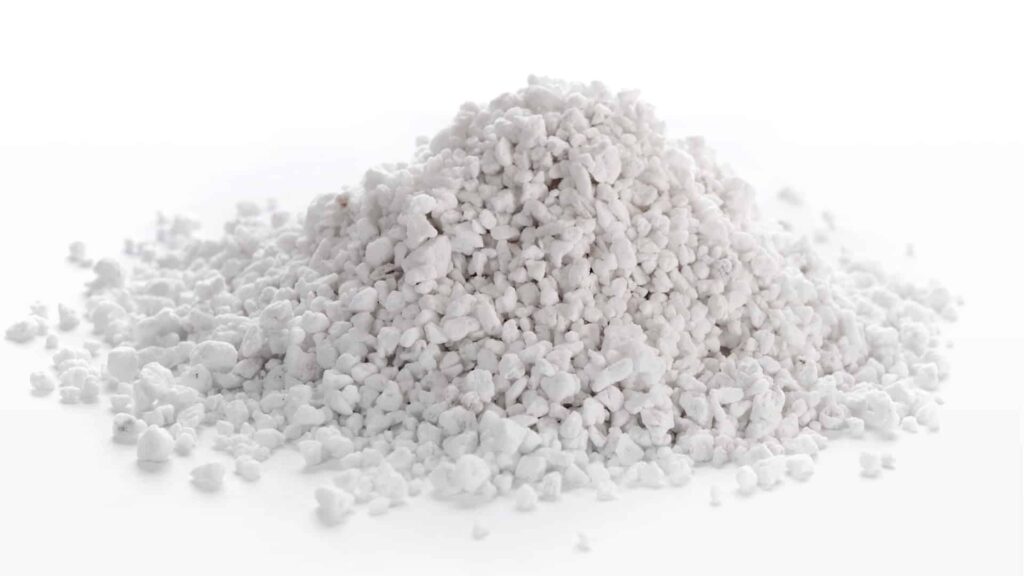
Another advantage is its exceptional drainage properties. The porous structure of perlite particles allows excess water to drain quickly, preventing waterlogging and the risk of root rot. This efficient drainage system ensures optimal oxygen availability to the plant roots, promoting robust growth and preventing the onset of diseases caused by improper moisture levels.
Moreover, it has the unique ability to retain water and nutrients, providing a stable and consistent environment for plant roots. The porous nature of perlite particles allows them to absorb and store moisture, gradually releasing it to the roots as needed. This water retention capacity ensures that plants receive a steady supply of hydration, reducing the frequency of watering and enhancing water efficiency in hydroponic systems.
A. The Benefits of Perlite in Hydroponic:
- Lightweight composition for easy handling and better aeration
- Excellent drainage properties to prevent waterlogging and root rot
- Ability to retain water and nutrients, providing a stable environment for plant roots
In addition to its functional benefits, it is also economically viable and readily available, making it a cost-effective choice for hydroponic growers. Its versatility allows it to be used in various hydroponic systems such as drip irrigation, NFT (Nutrient Film Technique), and ebb and flow setups.
Whether you are a beginner or an experienced hydroponic gardener, incorporating this into your system can significantly enhance the overall success of your plants. Its lightweight nature, excellent drainage properties, and water retention capabilities make it an essential component for hydroponic cultivation.
Perlite as a Soil Amendment
When it comes to optimizing soil conditions for plant growth, incorporating it can be a game-changer. This lightweight, volcanic glass material brings a host of benefits to your garden, including improved aeration, enhanced drainage, and increased root development. Let’s explore how it can transform your soil and promote the thriving growth of your plants.
A. Improved Aeration
One of the key advantages of using perlite as a soil amendment is its ability to improve aeration. The porous nature of this grow medium allows for increased airflow within the soil, preventing compaction and creating an optimal environment for root respiration. Ensuring adequate oxygen supply to the roots, helps plants perform essential metabolic functions, leading to healthier and more vigorous growth.
B. Enhanced Drainage
Excessive moisture in the soil can suffocate plant roots and promote the growth of harmful pathogens. By adding this to the soil, you can improve drainage and prevent waterlogging. The coarse texture of perlite creates air pockets that allow excess water to drain freely, maintaining the ideal moisture balance for plant roots. This helps to prevent root rot and other water-related issues, ensuring healthier plants.
C. Increased Root Development
When plants have access to well-drained soil with improved aeration, their root systems can thrive. It provides an excellent environment for root development, encouraging the growth of well-established root systems. As a result, plants can efficiently absorb water and nutrients from the soil, leading to stronger, more resilient plants with increased nutrient uptake.
Whether you’re cultivating a beautiful flower garden or growing vegetables, incorporating this growing media into your soil can make a noticeable difference. Its lightweight nature, combined with the ability to improve aeration, enhance drainage, and increase root development, makes it an invaluable tool for gardeners seeking optimal plant growth.
How to Prepare Perlite for Planting
Planting is a crucial step to ensure optimal plant growth and establishment. By following the proper hydration, sterilization techniques, and mixing ratios with other growing media, you can create an ideal environment for your plants to thrive.
Step 1: Hydrating
Start by hydrating perlite to improve its moisture-holding capacity. Place the desired amount of perlite in a container and slowly add water, stirring gently until it reaches a moist, sponge-like consistency. Avoid saturating this as excess water can lead to root rot and hinder plant growth.
Step 2: Sterilizing
To eliminate any potential pathogens or unwanted pests, sterilize perlite before use. Spread the hydrated perlite in a shallow tray and bake it in the oven at 200°F (93°C) for 30 minutes. This process will ensure a clean and sanitary growing-medium for your plants.
Step 3: Mixing with Growing Media
It is often used as an additive to improve soil drainage and aeration. When preparing a growing-medium, mix perlite with soil or other organic matter, such as peat moss or compost, in a ratio of 1 part perlite to 3 parts soil. This blend promotes essential root oxygenation and prevents waterlogging, facilitating nutrient uptake and overall plant health.
Expert Tip: For hydroponic systems, use a mix of perlite and vermiculite in equal parts to create a lightweight and well-draining medium that provides optimum support and moisture retention to the plants’ roots.
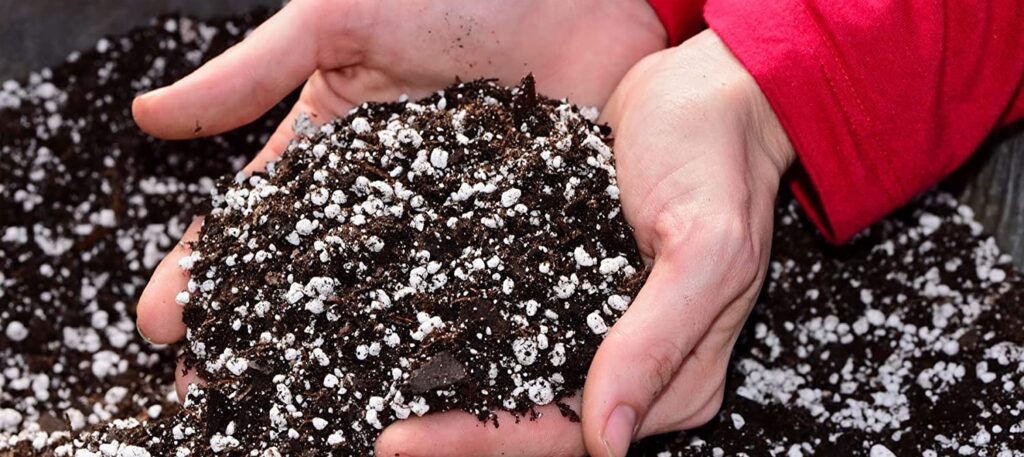
Enhancing Plant Growth
A. Promoting Nutrient Availability
One of the key advantages of using perlite for plants is its ability to promote nutrient availability. It allows it to retain essential nutrients and release them slowly over time, ensuring a steady supply for your plants. This helps to prevent nutrient deficiencies and ensures that your plants receive the necessary elements for robust growth and development.
B. Stimulating Root Growth
Healthy root development is crucial for thriving plants, and it can play a significant role in stimulating root growth. The lightweight and airy texture of perlite creates an optimal environment for roots to penetrate and expand. This encourages the growth of a dense and well-branched root system, leading to improved nutrient uptake, water absorption, and overall plant vigour.
C. Preventing Soil Compaction
Soil compaction can hinder plant growth by restricting root penetration and limiting the availability of oxygen and nutrients. It acts as a soil amendment to counteract this problem. Its lightweight particles create air pockets in the soil, improving aeration and preventing compaction. This promotes healthy root growth and allows plants to access the resources they need for optimal development.
D. Reducing the Risk of Plant Diseases
Plant diseases can be a significant threat to the health and productivity of your garden, but it can help mitigate this risk. Its swelling-draining properties prevent excess moisture from accumulating around the roots, reducing the likelihood of fungal diseases and root rot. Additionally, the improved aeration provided by perlite inhibits the growth of harmful bacteria and pathogens, creating a healthier environment for your plants.
Expert Tips for Using Perlite
A. Container Gardening
- Mixing Ratios: For optimal results, combine perlite with a well-draining potting mix at a ratio of 1:1. This will improve aeration and prevent waterlogging.
- Watering: It helps retain moisture while promoting proper drainage. Water your potted plants until the water drains out from the bottom, allowing excess moisture to escape.
- Reusing Perlite: After harvesting your plants, don’t discard the mixture. Simply remove any debris, sterilize it, and reuse it in future container gardening projects.
B. Seed Starting
When starting seeds, consider these tips:
- Gentle Sowing: Gently sow your seeds on a perlite and potting soil mix to provide a well-aerated environment for germination. Remember to follow the specific seed packet instructions for optimal depth and spacing.
- Moisture Control: Perlite’s ability to retain moisture can help prevent overwatering and damping-off diseases in seedlings. Keep the soil consistently moist but avoid excess moisture that can lead to rot.
- Optimal Germination: Ensure your seed tray or pots receive adequate light, warmth, and moisture for successful germination. It helps create the ideal microclimate for healthy seedling development.
C. Transplanting
When transplanting, remember these tips:
- Loosening Soil: Before transplanting, mix perlite into the surrounding soil to enhance its structure, loosen compacted areas, and improve aeration for better root growth.
- Amending Heavier Soils: If your garden soil is heavy or clayey, adding perlite can improve drainage and prevent waterlogged conditions that can harm plant roots.
- Reducing Shock: Perlite’s lightweight nature and insulating properties can help reduce transplant shock. Apply a layer of perlite to the bottom of the planting hole to create a barrier and protect delicate roots.
Sustainable and Eco-Friendly Properties of Perlite
It is a versatile growing-medium, that offers more than just benefits for plant growth. It is also renowned for its sustainable and eco-friendly properties. Let’s explore how perlite production aligns with environmental conservation and why it is an ideal choice for eco-conscious gardeners.
A. The Natural Abundance
It is a volcanic rock that is widely available in many regions around the world. With ample reserves, it can be extracted without depleting natural resources, ensuring a sustainable supply for gardeners.
B. Recyclability and Reusability
It is not only a renewable resource but also highly recyclable. Gardeners can easily reuse this, minimizing waste and reducing their environmental footprint. By implementing proper sterilization techniques, it can be safely reused for multiple growing seasons, making it a cost-effective and eco-conscious choice.
C. Minimal Environmental Impact
Unlike synthetic alternatives, it has a minimal impact on the environment. It is a naturally occurring material that does not release harmful chemicals or pollutants into the soil or water systems. When used as a growing-medium, it does not contribute to soil degradation or disrupt delicate ecosystems, making it environmentally friendly.
Eco-Friendly Table: Comparing
| Criteria | Perlite | Peat Moss | Coco Coir |
|---|---|---|---|
| Renewable Resource | Yes | No | Yes |
| Recyclable | Yes | No | Yes |
| Minimal Environmental Impact | Yes | No | Yes |
The table above highlights the sustainable advantages of perlite when compared to other commonly used growing-mediums, such as peat moss and coco coir. It’s renewable resource, recyclability, and minimal environmental impact set it apart as an eco-friendly option for gardeners.
Common Mistakes
There are some common mistakes that gardeners often make when using it. By being aware of these pitfalls, you can ensure optimal plant growth and overall success. Here are some insights on how to avoid these mistakes:
- Using the wrong grade of perlite: It’s essential to select the appropriate grade for your plants’ needs. Fine-grade perlite may be ideal for seed starting, while medium or coarse-grade perlite is better suited for container gardening or amending soil. Choose the grade that provides the right balance of aeration, drainage, and moisture retention for your specific plants.
- Not properly hydrating perlite: It should be hydrated before use to maximize its water-holding capacity. Failure to do so can result in perlite absorbing moisture from the root zone, leading to root rot or waterlogged soil. Soak this in water until fully saturated, then drain off any excess moisture before incorporating it into your grow medium.
- Overusing perlite in the grow medium: It is excellent for improving aeration and drainage, using too much can cause issues. The overabundance of perlite can create a fast-draining environment, leading to increased watering needs and nutrient leaching. Follow recommended ratios and balance this with other growing media to maintain optimal moisture levels.
- Using perlite as the sole grow medium: It works best when combined with other growing media, such as peat moss or coconut coir (coco coir). Using perlite alone may result in inadequate nutrient retention and limited root support. Create a well-balanced growing mix by incorporating this with other organic or inorganic matter.
- Neglecting to sterilize perlite: It should be sterilized before use to eliminate any potential pathogens or weed seeds. Failure to sterilize can introduce pests or diseases into your garden, compromising plant health. Heat perlite in an oven at 180-200°F (82-93°C) for at least 30 minutes to kill any unwanted organisms.
Tips for Buying and Storing
When it comes to buying and storing this, there are a few factors to consider to ensure that you are getting a quality product and maintaining its effectiveness. Here are some essential tips to keep in mind:
- Quality Indicators: Look for perlite that is lightweight, odourless, and free from impurities. High-quality perlite should have a consistent, uniform texture and colour.
- Package Considerations: Opt for perlite that is well-sealed to prevent moisture ingress and contamination. It is best to choose perlite in sturdy, resealable bags or containers that can be easily handled and stored.
- Proper Storage: To maintain its effectiveness, store it in a cool, dry place, away from direct sunlight and extreme temperatures. Keep the packaging tightly closed when not in use to prevent moisture absorption.
In addition to these tips, it may also be helpful to check for any specific storage recommendations provided by the manufacturer. Following these guidelines will ensure that your perlite remains in optimal condition for future use.
Conclusion
And there you have it, fellow plant enthusiasts! We’ve reached the end of our journey, and what a ride it’s been! From its incredible benefits to expert tips and tricks, we’ve covered it all. Now armed with the knowledge of how to prepare and use this growing media, you’re ready to take your gardening game to the next level. Through expert tips and techniques, you have learned how to prepare and utilize this effectively, unlocking its full potential for optimal plant growth.
So go ahead, grab your gardening instruments, get your hands dirty, and watch your plants thrive like never before. Happy gardening, everyone!


